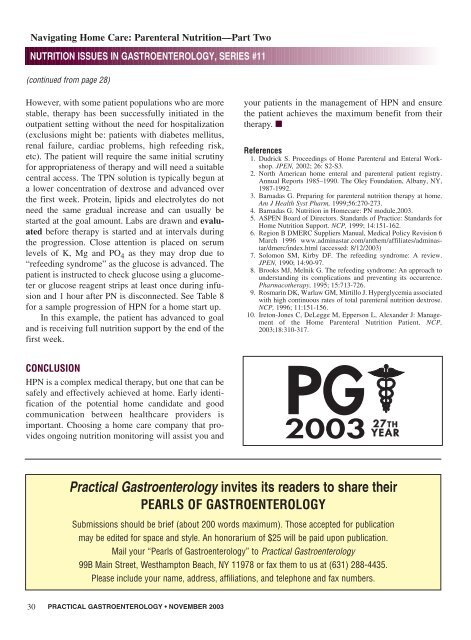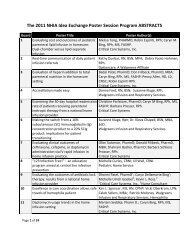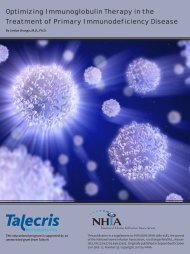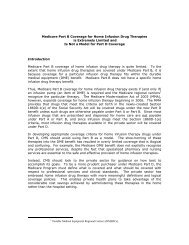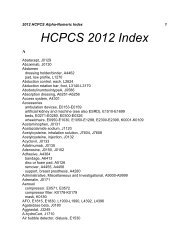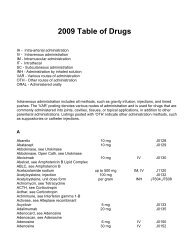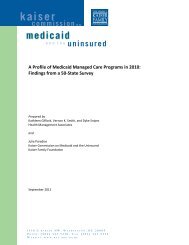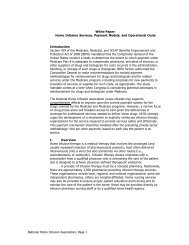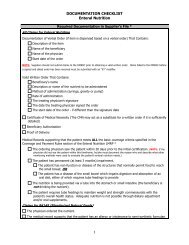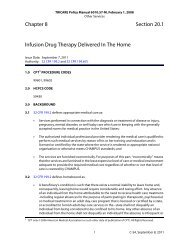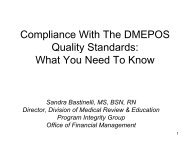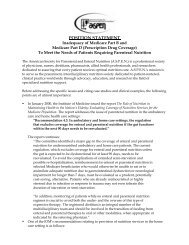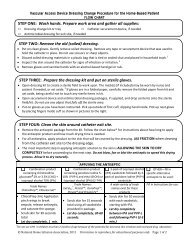Navigating Home Care: Parenteral Nutrition—Part Two
Navigating Home Care: Parenteral Nutrition—Part Two
Navigating Home Care: Parenteral Nutrition—Part Two
You also want an ePaper? Increase the reach of your titles
YUMPU automatically turns print PDFs into web optimized ePapers that Google loves.
<strong>Navigating</strong> <strong>Home</strong> <strong>Care</strong>: <strong>Parenteral</strong> <strong>Nutrition—Part</strong> <strong>Two</strong><br />
NUTRITION ISSUES IN GASTROENTEROLOGY, SERIES #11<br />
(continued from page 28)<br />
However, with some patient populations who are more<br />
stable, therapy has been successfully initiated in the<br />
outpatient setting without the need for hospitalization<br />
(exclusions might be: patients with diabetes mellitus,<br />
renal failure, cardiac problems, high refeeding risk,<br />
etc). The patient will require the same initial scrutiny<br />
for appropriateness of therapy and will need a suitable<br />
central access. The TPN solution is typically begun at<br />
a lower concentration of dextrose and advanced over<br />
the first week. Protein, lipids and electrolytes do not<br />
need the same gradual increase and can usually be<br />
started at the goal amount. Labs are drawn and evaluated<br />
before therapy is started and at intervals during<br />
the progression. Close attention is placed on serum<br />
levels of K, Mg and PO 4 as they may drop due to<br />
“refeeding syndrome” as the glucose is advanced. The<br />
patient is instructed to check glucose using a glucometer<br />
or glucose reagent strips at least once during infusion<br />
and 1 hour after PN is disconnected. See Table 8<br />
for a sample progression of HPN for a home start up.<br />
In this example, the patient has advanced to goal<br />
and is receiving full nutrition support by the end of the<br />
first week.<br />
your patients in the management of HPN and ensure<br />
the patient achieves the maximum benefit from their<br />
therapy. ■<br />
References<br />
1. Dudrick S. Proceedings of <strong>Home</strong> <strong>Parenteral</strong> and Enteral Workshop.<br />
JPEN, 2002; 26: S2-S3.<br />
2. North American home enteral and parenteral patient registry.<br />
Annual Reports 1985–1990. The Oley Foundation, Albany, NY,<br />
1987-1992.<br />
3. Barnadas G. Preparing for parenteral nutrition therapy at home.<br />
Am J Health Syst Pharm, 1999;56:270-273.<br />
4. Barnadas G. Nutrition in <strong>Home</strong>care: PN module,2003.<br />
5. ASPEN Board of Directors. Standards of Practice: Standards for<br />
<strong>Home</strong> Nutrition Support. NCP, 1999; 14:151-162.<br />
6. Region B DMERC Suppliers Manual, Medical Policy Revision 6<br />
March 1996 www.adminastar.com/anthem/affiliates/adminastar/dmerc/index.html<br />
(accessed: 8/12/2003)<br />
7. Solomon SM, Kirby DF. The refeeding syndrome: A review.<br />
JPEN, 1990; 14:90-97.<br />
8. Brooks MJ, Melnik G. The refeeding syndrome: An approach to<br />
understanding its complications and preventing its occurrence.<br />
Pharmacotherapy, 1995; 15:713-726.<br />
9. Rosmarin DK, Warlaw GM, Mirtillo J. Hyperglycemia associated<br />
with high continuous rates of total parenteral nutrition dextrose.<br />
NCP, 1996; 11:151-156.<br />
10. Ireton-Jones C, DeLegge M, Epperson L, Alexander J: Management<br />
of the <strong>Home</strong> <strong>Parenteral</strong> Nutrition Patient. NCP,<br />
2003;18:310-317.<br />
CONCLUSION<br />
HPN is a complex medical therapy, but one that can be<br />
safely and effectively achieved at home. Early identification<br />
of the potential home candidate and good<br />
communication between healthcare providers is<br />
important. Choosing a home care company that provides<br />
ongoing nutrition monitoring will assist you and<br />
PG<br />
2003 27<br />
27TH<br />
YEAR<br />
Practical Gastroenterology invites its readers to share their<br />
PEARLS OF GASTROENTEROLOGY<br />
Submissions should be brief (about 200 words maximum). Those accepted for publication<br />
may be edited for space and style. An honorarium of $25 will be paid upon publication.<br />
Mail your “Pearls of Gastroenterology” to Practical Gastroenterology<br />
99B Main Street, Westhampton Beach, NY 11978 or fax them to us at (631) 288-4435.<br />
Please include your name, address, affiliations, and telephone and fax numbers.<br />
30<br />
PRACTICAL GASTROENTEROLOGY • NOVEMBER 2003


